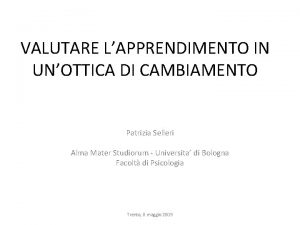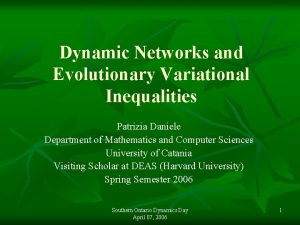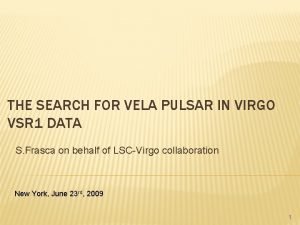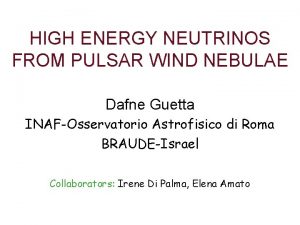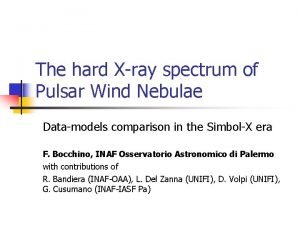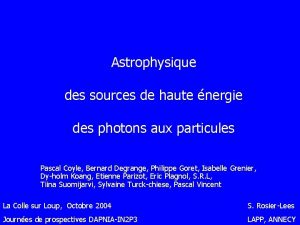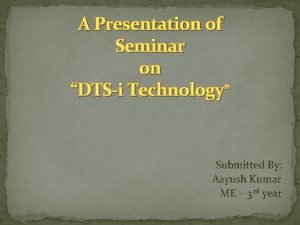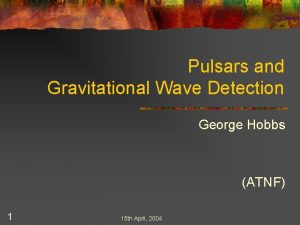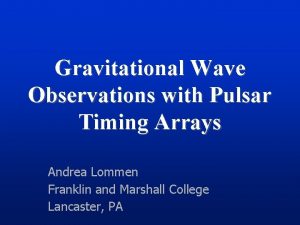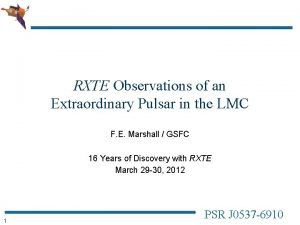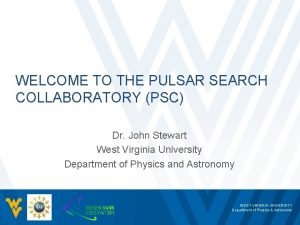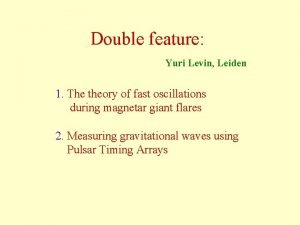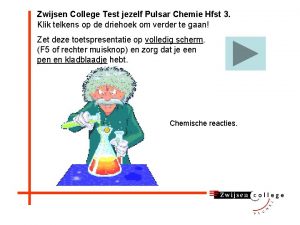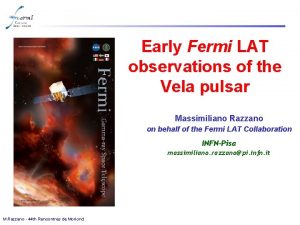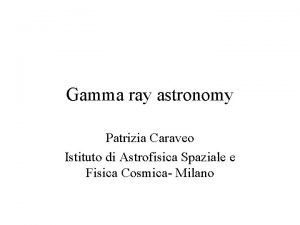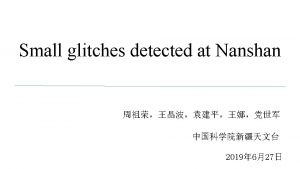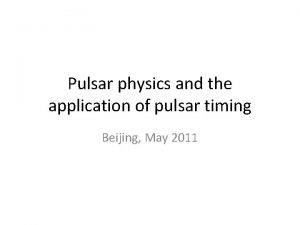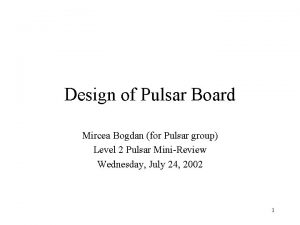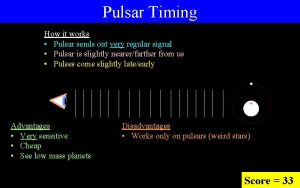The Fermi pulsar revolution Patrizia Caraveo A Population




































- Slides: 36

The Fermi pulsar revolution Patrizia Caraveo

A Population of Gamma-Ray Millisecond Pulsars Seen with the Fermi LAT Abdo, A. A. et al. 2009, Science, 325, 848 Detection of 16 Gamma-Ray Pulsars Through Blind Frequency Searches Using the Fermi LAT Abdo, A. A. et al. 2009, Science, 325, 840 Discovery of high-energy gammaray emission from the globular cluster 47 Tucanae with Fermi Abdo, A. A. et al. 2009, Science, 325, 845

2009 Breakthrough of the year

Fermi Pulsars Pulses at 1/10 th real rate EGRET pulsars young pulsars discovered using radio ephemeris pulsars discovered in blind search millisecond pulsars discovered using radio ephemeris

First Fermi LAT Pulsar Catalogue • 46 pulsars detected by the LAT using the first 6 months of LAT data • Of the 46, 16 resulted from blind searches, and 24 were discovered using ephemerides from radio monitoring*, including 8 MSPs TOTAL 17 radio quiet 21 radio PSR 8 msec PSR

Recent update (D. Smith) 8 new gamma selected pulsar, several new radio PSRs, Several of the newly detected msec PSRs

Unexpected finding • msec pulsars are as numerous as young pulsars

Radio-loud versus Radio-quiet. (Until Fermi, "Geminga" was the only gamma-loud, radio-quiet pulsar. ) radio emission cone WHY are we seeing so many radio quiet pulsars g-ray emission fan beam How can we study them ?

Forget optical emission

80’s 1988 Optical ID G” 1983 EPIC 2002 X-ray counterpart 1 E 0630+178 The power of X-ray Astronomy 70’s

X-ray vs gamma emission from • Classical (radio) NSs • msec PSR • Gamma-ray selected (Radio quiet) NSs • Are radio loud and radio quiet NSs behaving in the same way?

Gamma vs X-ray behaviour • Averaged fluxes Averaged spectra • Light curves • Phase-resolved spectra Standard analysis is needed In gamma-rays LAT catalogue In X-rays a re-analysis of the entire data base Martino Marelli Ph. D thesis

X-ray menu • • • No observation Exploratory Obs. Good spectral analysis “ “ “ but PWN also detected Excellent spectral analysis SWIFT Chandra XMM-Newton

X-ray menu • • • No observation Exploratory Obs. Good spectral analysis “ “ “ but PWN also detected Excellent spectral analysis SWIFT Chandra XMM-Newton

XRT image of J 0633 15

XRT image of J 1741 16

XRT image of J 1813 17

XRT image of J 1958 18

Archival searches: J 2032 XMM Chandra 19

X-ray menu • • • No observation Exploratory Obs. Good spectral analysis “ “ “ but PWN also detected Excellent spectral analysis SWIFT Chandra XMM-Newton

3 EG J 1835+5918 a. k. a. “Next Geminga” Brightest unidentified EGRET source off the plane A very faint, middle-aged INS LAT detection of pulsations! Erot=1· 1034 erg s-1 τ=1. 8 Myr 2 XMM observations (15 ks each) BB+PL spectrum (k. T~60 e. V, r~1. 5 km, Γ~1. 7) NH<2. 5· 1020 cm-2 FX~5· 10 -14 erg cm-2 s-1 (50% non-th)

X-ray menu • • • No observation Exploratory Obs. Good spectral analysis “ “ “ but PWN also detected Excellent spectral analysis SWIFT Chandra XMM-Newton

CTA 1 XMM observation

CTA 1 NS spectum pn mos NS thermal + NS power law + PWN power law

X-ray menu • • No observation Exploratory Obs. Good spectral analysis “ “ “ but PWN also detected SWIFT Chandra XMM-Newton • Excellent spectral analysis

Geminga 100 ksec, pn 53, 000 ph PSR 0656+14 pn 35 ksec 120, 000 ph PSR 1055 -57 pn 60 ksec 85, 000 ph

Geminga PSR 0656+14 PSR 1055 -57




Msec Radio gamma


Msec Radio gamma


Msec Radio Gamma IBIS

Fgamma/Fx vs Erot • Large scatter for NSs with similar Erot (note that the ratio does not depend on distance uncertainty) • Radio loud pulsars seem to have lower ratio than radio quiet ones (i. e. radio quiet are underluminous in X-rays). • Observational biases should also be considered • More to come- stay tuned
 Patrizia signorelli model
Patrizia signorelli model Patrizia palomba
Patrizia palomba Patrizia neerman
Patrizia neerman Giuseppe valitutti
Giuseppe valitutti Bilanciamento reazioni
Bilanciamento reazioni Patrizia selleri
Patrizia selleri Patrizia farci
Patrizia farci Francesco petrarca mappa concettuale
Francesco petrarca mappa concettuale Patrizia lemma
Patrizia lemma Liceo scientifico g. battaglini
Liceo scientifico g. battaglini Patrizia daniele
Patrizia daniele Patrizia garbin psicologa
Patrizia garbin psicologa Istituto di analisi fiorentino
Istituto di analisi fiorentino Patrizia gentili agid
Patrizia gentili agid Biography of patricia benner
Biography of patricia benner Patrizia luna
Patrizia luna Patrizia luna
Patrizia luna Giuseppe valitutti
Giuseppe valitutti Professor patrizia simondo
Professor patrizia simondo Population ecology section 1 population dynamics answer key
Population ecology section 1 population dynamics answer key Chapter 4 section 1 population dynamics
Chapter 4 section 1 population dynamics Section 1 population dynamics
Section 1 population dynamics Population ecology section 1 population dynamics
Population ecology section 1 population dynamics Vela pulsar
Vela pulsar Pulsar wind
Pulsar wind Pulsar wind
Pulsar wind Pulsar solaire
Pulsar solaire Bajaj pulsar 180 dtsi digital twin spark ignition
Bajaj pulsar 180 dtsi digital twin spark ignition Pulsar analytics
Pulsar analytics Pulsar timing
Pulsar timing Pulsar
Pulsar Pulsar
Pulsar Pulsar search collaboratory
Pulsar search collaboratory Pulsar
Pulsar Pulsar timing
Pulsar timing Vraag 3
Vraag 3 Pulsar
Pulsar





